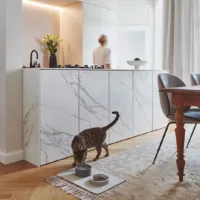Are you looking to teach your cat some new tricks or simply want to strengthen your bond with your feline friend? You’re in the right place! Training your cat can be a fun and rewarding experience for both you and your pet. In this guide, we’ll explore effective training methods, rewards, and tips to help you create a positive and engaging environment for your feline friend.
Laying the foundation for successful cat training
Realistic expectations
Training your cat starts with the mindset that you’re helping your cat to become content and happy. Remember to build up training gradually, rewarding your cat for remaining relaxed, and being consistent with the house rules you set early on. This way you’ll create a solid foundation for successful training.
Understanding your cat’s unique traits
Your cat’s age and breed can play a significant role in its responsiveness to training. If your feline friend has experienced food scarcity in the past, you may need to exercise extra patience during training sessions, as she might be eager to snatch treats from your hands. Additionally, if your cat is older and unaccustomed to training, she may not readily respond to your requests for attention (same for young kittens). Remember, patience and understanding are key when working with your cat’s unique characteristics and background.
Keep it short
Timing is everything when it comes to training your cat. Cats have short attention spans, so keep your training sessions brief – around 5 to 10 minutes per session. You can hold multiple sessions throughout the day, but avoid overwhelming your cat with too much information at once.
Breakt tricks into small steps
Breaking tricks into small, manageable steps will make it easier for your cat to learn. For example, if you want to teach your cat to high-five, start by rewarding them for lifting its paw. Gradually progress to having them touch your hand, and then move on to the actual high-five motion.
Celebrate success
Be sure to reward them immediately and consistently after they successfully complete a task. Cats may not respond as easily to treats as dogs do, but warmth, attention, or stroking can be used as powerful motivators.
Teaching essential life skills
Training your cat isn’t just about teaching them cool tricks; it’s about helping it become well-adjusted and adaptable to various situations. Start by focusing on essential life skills, such as feeling comfortable in a cat carrier, getting used to car journeys, tolerating grooming, and receiving basic health examinations and treatments. This kind of training will help your cat cope better with visits to the vet.
Clicker training: A fun and effective training method
Clicker training can be an incredibly effective way to teach your cat desired behaviors. A clicker is a small device that clicks when pressed. Before starting, ensure your cat understands the connection between the click and the reward. Simply feed it one treat at a time and press the clicker. Your cat will learn to associate the click with something good. Now incorporate the small steps we discussed earlier.
By clicking when your cat performs the desired behavior and immediately offering a treat, your cat will learn to expect a reward for the behavior. Instead of using a physical clicker, you can create a clicking sound with your mouth or call your cat by its name to achieve the same effect. By doing so, your cat will associate the sound or its name with receiving a treat, ultimately learning to come to you when called.
Once your cat becomes accustomed to the clicking sound or its name being associated with rewards, you’ll find it much easier to gain its attention during training sessions and other activities. Speaking of keeping your cat engaged, let’s move on to the importance of toys, puzzles, and exploration in maintaining a stimulating environment for your feline friend.
Keeping your cat engaged: Toys, puzzles, and exploration
A stimulating environment is essential for keeping your cat happy and engaged. There are tons of options for you to choose from:
- Interactive toys: Offer toys that mimic real prey and engage your cat’s hunting instincts.
- Self-play toys: Provide toys your cat can enjoy on its own to prevent boredom.
- Toy rotation: Rotate toys regularly to maintain novelty and prevent boredom.
- Cardboxes and paper bags: Providing your cat with simple exploration opportunities can satisfy its curiosity and need for hiding spaces.
- Food puzzles: Encourage your cat to work for its food with puzzle feeders or by scattering food for them to find.
Conclusion
Training your cat can be an enjoyable and rewarding way to bond with your pet while teaching them new behaviors and essential life skills. By following these tips and techniques, you’ll be well on your way to having a well-behaved, happy, and well-adjusted feline friend. So, grab some treats and start training today!
If you enjoyed and benefited from this guide, don’t forget to share the love with your friends – they’ll appreciate the helpful tips too!








